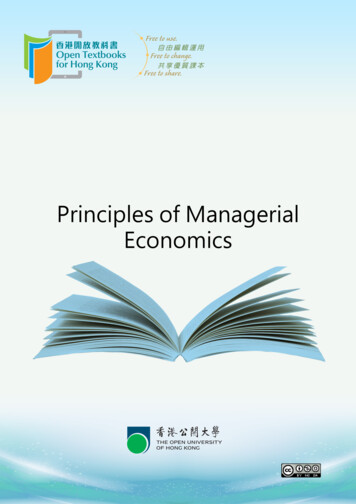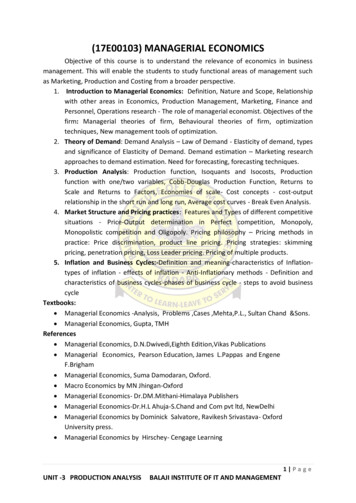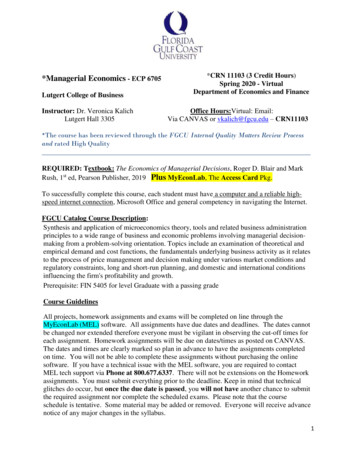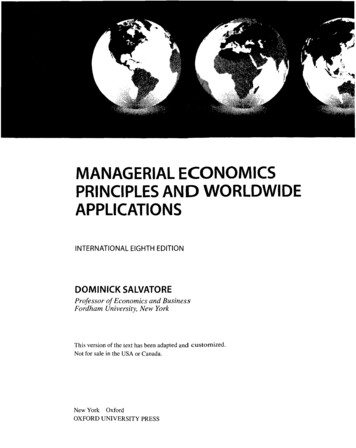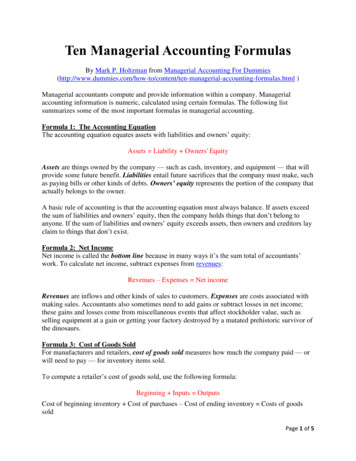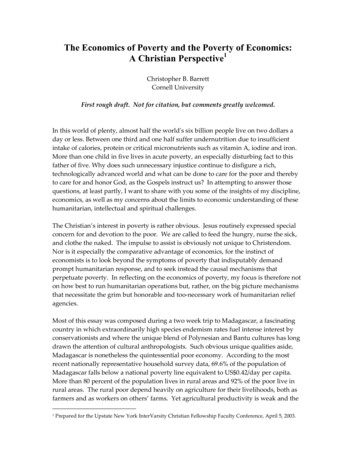
Transcription
Managerial Economics1
Managerial EconomicsAbout the TutorialManagerial economics is concerned with the application of economic concepts andeconomic analysis to the problems of formulating rational managerial decisions.This tutorial covers most of the topics of managerial economics including micro,macro, and managerial economic relationship; demand forecasting, productionand cost analysis, market structure and pricing theory.AudienceThis tutorial is aimed at management students having a basic understanding ofbusiness concepts. It will give them an in-depth overview of the major topics ofmanagerial economics.PrerequisitesIt is an elementary tutorial and you can easily understand the concepts explainedhere with a basic knowledge of management studies.Copyright & Disclaimer Copyright 2015 by Tutorials Point (I) Pvt. Ltd.All the content and graphics published in this e-book are the property of TutorialsPoint (I) Pvt. Ltd. The user of this e-book is prohibited to reuse, retain, copy,distribute or republish any contents or a part of contents of this e-book in anymanner without written consent of the publisher.We strive to update the contents of our website and tutorials as timely and asprecisely as possible, however, the contents may contain inaccuracies or errors.Tutorials Point (I) Pvt. Ltd. provides no guarantee regarding the accuracy,timeliness or completeness of our website or its contents including this tutorial. Ifyou discover any errors on our website or in this tutorial, please notify us atcontact@tutorialspoint.comi
Managerial EconomicsTable of ContentsAbout the Tutorial . iAudience . iPrerequisites . iCopyright & Disclaimer . iTable of Contents. iiPART 1: INTRODUCTION. 11.MANAGERIAL ECONOMICS – AN OVERVIEW . 2Managerial Economics – Definition . 2Micro, Macro, and Managerial Economics Relationship . 2Nature and Scope of Managerial Economics . 2Role in Managerial Decision Making . 52.BUSINESS FIRMS AND BUSINESS DECISIONS . 6Steps for Decision Making . 6Sensitivity Analysis . 73.ECONOMIC ANALYSIS & OPTIMIZATIONS. 8Optimization Analysis . 9Total Revenue and Total Cost Approach . 9Marginal Revenue and Marginal Cost Approach . 94.REGRESSION TECHNIQUE . 11Simple Regression . 11Multiple Regression Analysis . 15PART 2: DEMAND FORECASTING. 175.MARKET SYSTEM & EQUILIBRIUM. 18The Economic Systems . 18Demand and Supply Curves . 186.DEMAND & ELASTICITIES . 21Changes in Demand . 21Concept of Elasticity . 21Elasticity of Demand . 22Factors Affecting Price Elasticity of Demand . 23Cross Elasticity of Demand . 24Total Revenue (TR) and Marginal Revenue . 24Price Ceiling and Price Flooring . 257.DEMAND FORECASTING . 27Demand . 27Law of Demand . 27Theory of Consumer Behavior . 28Marginal Utility Analysis . 29Indifference Curve Analysis . 30ii
Managerial EconomicsConsumer Equilibrium . 31PART 3: PRODUCTION & COST ANALYSIS . 338.THEORY OF PRODUCTION . 34Function . 34Production Analysis . 34Cost Function . 35Law of Variable Proportions . 369.COST & BREAKEVEN ANALYSIS . 39Cost Concepts . 39Future and Past Costs . 39Incremental and Sunk Costs . 39Types of Costs . 41Determinants of Cost . 41Short-Run Cost-Output Relationship . 42Long-Run Cost-Output Relationship . 42Economies and Diseconomies of Scale . 42Contribution and Breakeven Analysis . 43Breakeven chart . 44PART 4: MARKET STRUCTURE & PRICING THEORY . 4610. MARKET STRUCTURE & PRICING DECISIONS . 47Market Structure . 47Perfect Competition . 47Pricing Decisions . 48Monopolistic Competition . 48Monopoly . 49Oligopoly . 5011. PRICING STRATEGIES . 51Pricing a New Product . 51Multiple Products . 52Full Cost Pricing Method . 52Marginal Cost Pricing Method . 52Transfer Pricing . 52Dual Pricing . 53Price Effect . 53Substitution Effect . 54Income Effect . 54PART V: CAPITAL BUDGETING . 5512. INVESTMENT UNDER CERTAINTY . 56Non-Discounted Cash Flow . 56Discounted Cash Flow Techniques . 57Profitability Index (PI) . 58iii
Managerial EconomicsInternal Rate of Return (IRR) . 5913. INVESTMENT UNDER UNCERTAINTY . 61Statistical Techniques for Risk Analysis . 61PART VI: MACROECONOMIC ASPECTS . 6314. MACROECONOMICS BASICS . 64Nature of Macroeconomics . 64Scope of Macroeconomics. 6415. CIRCULAR FLOW MODEL OF ECONOMY . 6616. NATIONAL INCOME AND MEASUREMENT . 68Definition of National Income . 68Measures of National Income . 68Methods of Measuring National Income . 7017. NATIONAL INCOME DETERMINATION . 71Factors Determining the National Income . 7118. MODERN THEORIES OF ECONOMIC GROWTH . 72Definition of Economic Growth . 72Theories of Economic Growth . 7219. BUSINESS CYCLES AND STABILIZATION . 74Theories of Business Cycles . 74Stabilization Policies . 75Instruments of Stabilization Policies . 7520. INFLATION & ITS CONTROL MEASURES . 76Inflation . 76Causes of Inflation . 76Measures to Control Inflation. 76Impact of Inflation on Managerial Decision Making . 77iv
Managerial EconomicsPART 1: INTRODUCTION1
Managerial Economics1. MANAGERIAL ECONOMICS – AN OVERVIEWA close interrelationship between management and economics had led to thedevelopment of managerial economics. Economic analysis is required for variousconcepts such as demand, profit, cost, and competition. In this way, managerialeconomics is considered as economics applied to “problems of choice’’ oralternatives and allocation of scarce resources by the firms.Managerial economics is a discipline that combines economic theory withmanagerial practice. It helps in covering the gap between the problems of logicand the problems of policy. The subject offers powerful tools and techniques formanagerial policy making.Managerial Economics – DefinitionTo quote Mansfield, “Managerial economics is concerned with the application ofeconomic concepts and economic analysis to the problems of formulating rationalmanagerial decisions.Spencer and Siegelman have defined the subject as “the integration of economictheory with business practice for the purpose of facilitating decision making andforward planning by management.”Micro, Macro, and Managerial Economics RelationshipMicroeconomics studies the actions of individual consumers and firms;managerial economics is an applied specialty of this branch. Macroeconomicsdeals with the performance, structure, and behavior of an economy as a whole.Managerial economics applies microeconomic theories and techniques tomanagement decisions. It is more limited in scope as compared tomicroeconomics. Macroeconomists study aggregate indicators such as GDP,unemployment rates to understand the functions of the whole economy.Microeconomics and managerial economics both encourage the use of quantitativemethods to analyze economic data. Businesses have finite human and financialresources; managerial economic principles can aid management decisions inallocating these resources efficiently. Macroeconomics models and their estimatesare used by the government to assist in the development of economic policy.Nature and Scope of Managerial EconomicsThe most important function in managerial economics is decision making. Itinvolves the complete course of selecting the most suitable action from two or2
Managerial Economicsmore alternatives. The primary function is to make the most profitable use ofresources which are limited such as labor, capital, land etc. A manager is verycareful while taking decisions as the future is uncertain; he ensures that the bestpossible plans are made in the most effective manner to achieve the desiredobjective which is profit maximization. Economic theory and economic analysis are used to solve the problems ofmanagerial economics. Economics basically comprises of two main divisions namely Microeconomics and Macro economics.MicroeconomicsMacroeconomicsDemand andsupply betweenindividualsTotal ersStudies related to local,national, regional andglobal economies Managerial economics covers both macroeconomics as well as microeconomics, as both are equally important for decision making and businessanalysis. Macroeconomics deals with the study of entire economy. It considers all thefactors such as government policies, business cycles, national income, etc. Microeconomics includes the analysis of small individual units of economysuch as individual firms, individual industry, or a single individual consumer.All the economic theories, tools, and concepts are covered under the scope ofmanagerial economics to analyze the business environment. The scope ofmanagerial economics is a continual process, as it is a developing science. Demandanalysis and forecasting, profit management, and capital management are alsoconsidered under the scope of managerial economics.3
Managerial EconomicsDemand Analysis andForecastingManagerial EconomicsProfit ManagementCapital ManagementDemand Analysis and ForecastingDemand analysis and forecasting involves huge amount of decision making!Demand estimation is an integral part of decision making, an assessment of futuresales helps in strengthening the market position and maximizing profit. Inmanagerial economics, demand analysis and forecasting holds a very importantplace.Profit ManagementSuccess of a firm depends on its primary measure and that is profit. Firms areoperated to earn long-term profit which is generally the reward for risk taking.Appropriate planning and measuring profit is the most important and challengingarea of managerial economics.Capital ManagementCapital management involves planning and controlling of expenses. There aremany problems related to capital investments which involve considerable amountof time and labor. Cost of capital and rate of return are important factors of capitalmanagement.Demand for Managerial EconomicsThe demand for this subject has increased post liberalization and globalizationperiod primarily because of increasing use of economic logic, concepts, tools andtheories in the decision making process of large multinationals.Also, this can be attributed to increasing demand for professionally trainedmanagement personnel, who can leverage limited resources available to them andmaximize returns with efficiency and effectiveness.4
Managerial EconomicsRole in Managerial Decision MakingManagerial economics leverages economic concepts and decision sciencetechniques to solve managerial problems. It provides optimal solutions tomanagerial decision making issues.5
2. BUSINESS FIRMS AND BUSINESS DECISIONSManagerial EconomicsBusiness firms are a combination of manpower, financial, and physical resourceswhich help in making managerial decisions. Societies can be classified into twomain categories - production and consumption. Firms are the economic entitiesand are on the production side, whereas consumers are on the consumption side.The performances of firms get analyzed in the framework of an economic model.The economic model of a firm is called the theory of the firm. Business decisionsinclude many vital decisions like whether a firm should undertake research anddevelopment program, should a company launch a new product, etc.Business decisions made by the managers are very important for the success andfailure of a firm. Complexity in the business world continuously grows making therole of a manager or a decision maker of an organisation more challenging! Theimpact of goods production, marketing, and technological changes highlycontribute to the complexity of the business environment.Steps for Decision MakingThe steps for decision making like problem description, objective determination,discovering alternatives, forecasting consequences are described below:Define the ProblemWhat is the problem and how does it influence managerial objectives are the mainquestions. Decisions are usually made in the firm’s planning process. Managerialdecisions are at times not very well defined and thus are sometimes source of aproblem.Determine the ObjectiveThe goal of an organization or decision maker is very important. In practice, theremay be many problems while setting the objectives of a firm related to profitmaximization and benefit cost analysis. Are the future benefits worth the presentcapital? Should a firm make an investment for higher profits for over 8 to 10years? These are the questions asked before determining the objectives of a firm.Discover the AlternativesFor a sound decision framework, there are many questions which are needed tobe answered such as: What are the alternatives? What factors are under the6
Managerial Economicsdecision maker’s control? What variables constrain the choice of options? Themanager needs to carefully formulate all such questions in order to weigh theattractive alternatives.Forecast the ConsequencesForecasting or predicting the consequences of each alternative should beconsidered. Conditions could change by applying each alternative action so it iscrucial to decide which alternative action to use when outcomes are uncertain.Make a ChoiceOnce all the analysis and scrutinizing is completed, the preferred course of actionis selected. This step of the process is said to occupy the lion’s share in analysis.In this step, the objectives and outcomes are directly quantifiable. It all dependson how the decision maker puts the problem, how he formalizes the objectives,considers the appropriate alternatives, and finds out the most preferable courseof action.Sensitivity AnalysisSensitivity analysis helps us in determining the strong features of the optimalchoice of action. It helps us to know how the optimal decision changes, ifconditions related to the solution are altered. Thus, it proves that the optimalsolution chosen should be based on the objective and well structured. Sensitivityanalysis reflects how an optimal solution is affected, if the important factors varyor are altered.Managerial economics is competent enough for serving the purposes in decisionmaking. It focuses on the theory of the firm which considers profit maximizationas the main objective. The theory of the firm was developed in the nineteenthcentury by French and English economists. Theory of the firm emphasizes onoptimum utilization of resources, cost control, and profits in a single time period.Theory of the firm approach, with its focus on optimization, is relevant for smallfarms and producers.7
3. ECONOMIC ANALYSIS & OPTIMIZATIONSManagerial EconomicsEconomic analysis is the most crucial phase in managerial economics. A managerhas to collect and study the economic data of the environment in which a firmoperates. He has to conduct a detailed statistical analysis in order to do researchon industrial markets. The research may comprise of information regarding taxrates, products, competitor’s pricing strategies, etc., which may be useful formanagerial decision making.Optimization techniques are very crucial activities in managerial decision makingprocess. According to the objective of the firm, the manager tries to make themost effective decision out of all the alternatives available. Though the optimaldecisions differ from company to company, the objective of optimization techniqueis to obtain a condition under which the marginal revenue is equal to the marginalcost.The first step in presenting optimization techniques is to examine the methods toexpress economic relationship. Now let’s have a look at the methods of expressingeconomic relationship: Equations, graphs, and tables are extensively used for expressing economicrelationships. Graphs and tables are used for simple relationships and equations are usedfor complex relationships. Expressing relationships through equations is very useful in economics asit allows the usage of powerful differential technique, in order to determinethe optimal solution of the problem.Now suppose, we have total revenue equation:TR 100Q 10Q2Substituting values for quantity sold, we generate the total revenue schedule ofthe firm:100Q - 10Q2TR100(0) - 10(0)2 0100(1) - 10(1)2 90100(2) - 10(2)2 160100(3) - 10(3)2 2108
Managerial Economics100(4) - 10(4)2 240100(5) - 10(5)2 250100(6) - 10(6)2 240Relationship between total, marginal, average concepts, and measures is reallycrucial in managerial economics. Total cost comprises of total fixed cost plus totalvariable cost or average cost multiply by total number of units producedTC TFC TVC or TC AC. QMarginal cost is the change in total cost resulting from one unit change in output.Average cost shows per unit cost of production, or total cost divided by number ofunits produced.Optimization AnalysisOptimization analysis is a process through which a firm estimates or determinesthe output level and maximizes its total profits. There are basically two approachesfollowed for optimization: Total revenue and total cost approach Marginal revenue and Marginal cost approachTotal Revenue and Total Cost ApproachAccording to this approach, total profit is maximum at the level of output wherethe difference between the TR and TC is maximum.Π TR TCWhen output 0, TR 0, but TC 20, so total loss 20When output 1, TR 90, and TC 140, so total loss 50At Q2, TR TC 160, therefore profit is equal to zero. When profit is equal to zero,it means that firm reached a breakeven point.Marginal Revenue and Marginal Cost ApproachAs we have seen in TR and TC approach, profit is maximum when the differencebetween them is maximum. However, in case of marginal analysis, profit ismaximum at a level of output when MR is equal to MC. Marginal cost is the changein
managerial economics is an applied specialty of this branch. Macroeconomics deals with the performance, structure, and behavior of an economy as a whole. Managerial economics applies microeconomic theories and techniques to management decisions. I

